Last Updated on July 7, 2023 by asoulwindow
Table of Contents
Tiger Safari in Tadoba National Park
I had amazing wildlife sightings on both, the morning and the amazing offbeat night safaris which I took in Tadoba National Park. They say, it is easier to spot a wild tiger in Tadoba Andhari Tiger Reserve, a hidden gem of Central India.
I had always wanted to find it out. But somehow a visit to Tadoba always eluded me. Finally, the stars aligned and Tadoba beckoned me. I explored the core zone of Tadoba with my friend Ami Bhat who is also one of the best travel bloggers in India. We explored Tadoba Andhari Tiger Reserve from the Khutwanda Gate during morning jeep safari and the buffer zone in the offbeat Navegaon Ramdegi Gate for exciting night safari. The tiger density is so high in Tadoba National Park, that it is common to spot tigers on even the tarmac roads.
Can I see a tiger in Tadoba National Park: Wildlife Sighting Predictions
- How likely is it to see a tiger in Tadoba?
- Can we see tigers in Tadoba National Park?
- What are my chances of seeing tiger in Tadoba?
These questions clouded my mind as I woke up at the auspicious Brahma Muhurat of 4 a.m. at the luxurious Waghoba Eco Lodges by Pugdundee Safaris. This sprawling property next to the core zone of Tadoba is a destination in itself. Why would anyone want to leave it and go elsewhere. Had it not been the love for all things wild, I would have just stayed back and enjoyed the property. But, we couldn’t wait to hop on to the jeep when it arrived at the reception of Waghoba Eco Lodge. The colours of sunrise splashed across the sky made the Brahma Muhurat all the more ethereal.

I asked Ami to dramatically close her eyes and tell me what and how many animals are we going to see in today’s morning jeep safari in Tadoba? She played along and confidently said, “1 mother tiger and two cubs.” Till this happened, the art of predicting wildlife sightings with precision and accuracy was mastered only by our common friend Divyakshi Gupta, also a top travel blogger from India. “We will see a Rhinoceros and a baby”, Divyakshi said as we explored Chitwan National Park in the terai region of beautiful Nepal. Just when we lost all hope of any good sighting and were leaving Chitwan National Park, we saw exactly that. A rhino and a baby.
Let’s see if Ami is giving stiff competition to Divyakshi here? Will her predictions come true? We will find out in this comprehensive blog to Tiger Safari in Tadoba National Park which is based on my own experience of a jeep safari here.
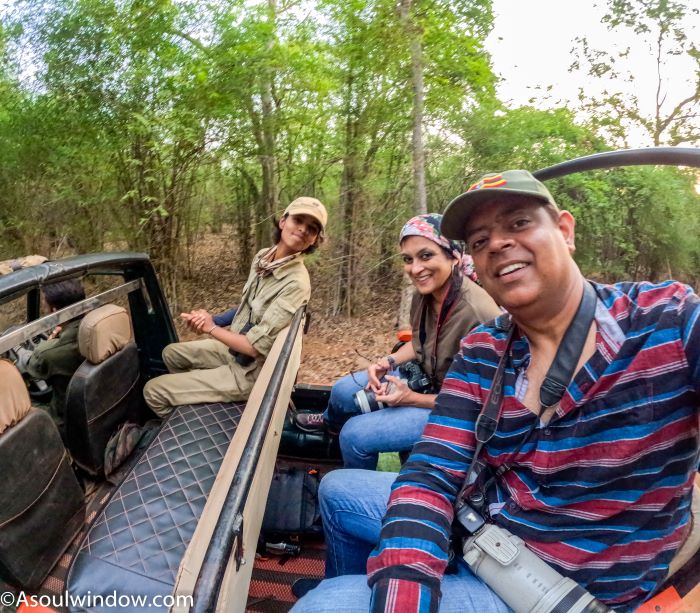
Spotting Tigers in Jamni Lake of Tadoba National Park
Our hankering after the elusive tiger was only growing. Though I had not done a jeep safari here yet, but I was optimistic about my chances of spotting a wild Tiger in Tadoba National Park. I had read several personal accounts of people who were successful in spotting several tigers in Tadoba National Park, especially in summer. Since I explored Tadoba Andhari Tiger Reserve on 11th June, the peak of North Indian summer, I was very hopeful for the sighting of Tiger. The weather was in my favour, besides the stars!
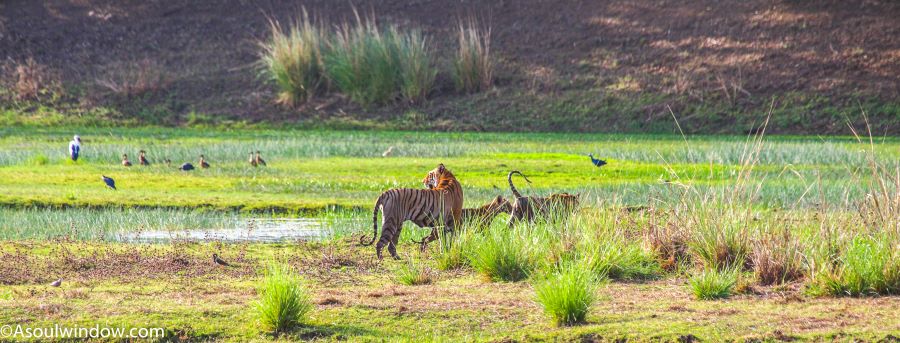
The big moment arrived in no time. As we were busy locking eyes with the chitals, we rushed towards a large open field when we saw a row of safari jeeps queued up, frantically burying their noses beneath the binoculars. With naked eyes and the maximum reach of my zoom lens, I could see only aquatic birds such as Asian open bill storks, Red Naped Ibis and many whistling ducks in the foreground of the dense tall grass.
Soul Window Suspense
The suspense was building up, as my naturalist said she saw a tiger there. “There, right behind the tall grass.”, she said. The alarm calls could be clearly heard. “But why was I not able to spot the orange in a dewy green landscape?”
It was a large water body. Shaheen told me, it is Jamni Lake, popular with birds and tigers alike. We had already spotted a marsh crocodile lurking in the nearby Tadoba lake, which is much larger.Except for the tall green grass, nothing else could hide a beast so big. There was no roar either. But then the roars are heard mostly in outdated zoos which I consciously stay away from, whether India or Sydney. I have never heard a tiger roar in the wild. It was a clear, crisp morning! The field was as open and clear as the rugged savannas (minus so much green) of Kidepo National Park of Uganda which I visited earlier.
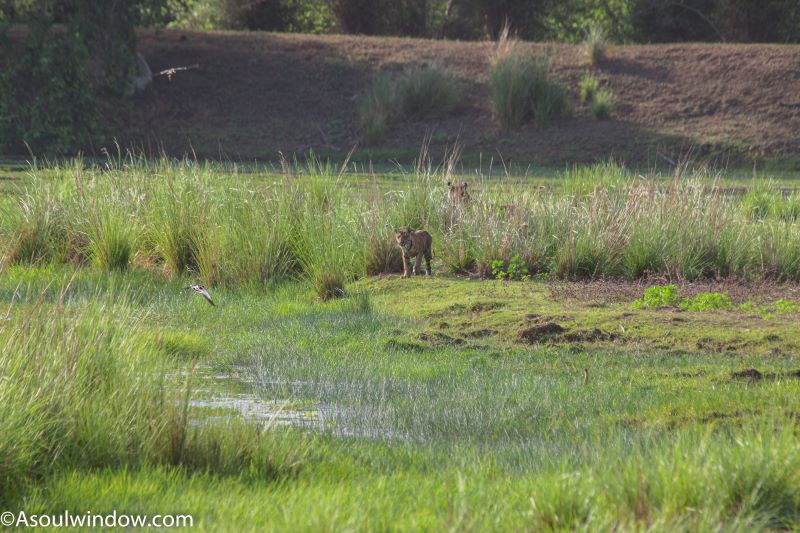
Where is the damn tiger which every-one has seen by now? There, there she is! My heart pounded as I had my first glimpse of the orange flames tearing apart the greens.
A cub appeared first. Innocent faced and seemingly harmless. Indian and western media have given bad press to wild animals unnecessarily. The animals never harm sans a valid reason. The cub shook his head left and right in quick action to drain off the excess water. The water droplets made a circle around the head. I missed a great shot! But then, it was a sign of something even better. With bated breath, I anticipated the cub to walk out of grass, forcing others to follow. It happened exactly like my prediction! The people on jeep went berserk and click happy. It left me slack-jawed.The ducks and the storks were nonchalant and unafraid though!

Bijli Tigress and her cubs: Unforgettable Tiger sighting
Bijli started to walk lazily with her two cubs but she was in no rush. As if she was planted in that field to give us a good look, she preened and played with her cubs for a while. The cubs are not given names; not many survive anyways. Shaheen told me that the name of the mother is Bijli. After a few seconds, Bijli, a famous tiger in Tadoba National Park, started to pose for us with her two cubs. It was as if she was walking a ramp in some fashion week.
Ami smiled smugly as her predictions started to manifest itself eerily. Divyakshi has a new competition! People in other jeeps ooh and aahed as they gasped at the stunning sighting of the Royal Bengal Tigress. We were fortunate that Bijli didn’t hurry and remained visible with her cubs for a long time. The majestic tigress gave us ample time to observe her behaviour. We just wished she was closer to us.
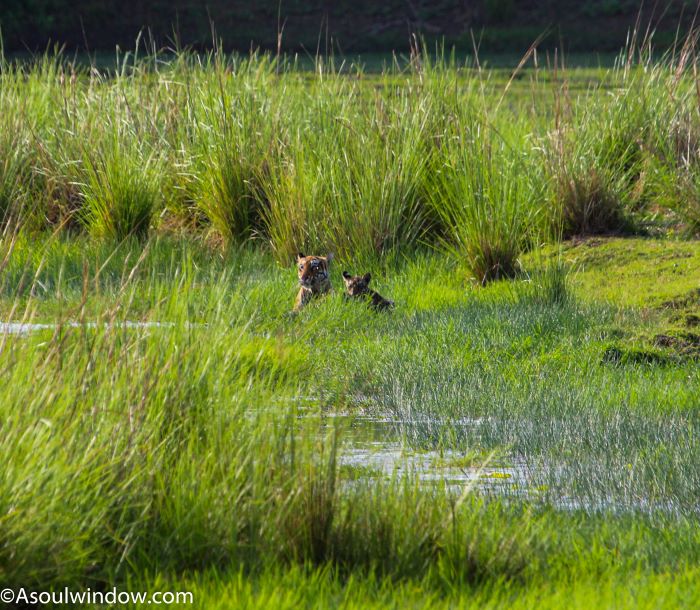
Shaheen, the in-house naturalist at Waghoba Eco Lodge told me that Bijli is the sister of Roma, another famous tiger of Tadoba National Park. The once-dominating tigress Chhoti Tara of Jamni is their mother. Roma also has cubs at the time when we visited. Much of what was once a territory of Chhoti Tara has now been usurped by Bijli and Roma who have pushed their mother to the fringes of the forest. Tigers prefer habitats which have water bodies, grasslands and most importantly a good prey base.
Sonam Tigress and her cubs at Telia Lake, Moharli Gate
Shaheen, the talented naturalist of Pugdundee Safaris proposed that we go to the Telia lake near the popular Moharli gate of Tadoba National Park.
“A tiger called as Sonam and her very young cubs are recently spotted resting on the banks of Telia lake regularly. There is a good chance that we may spot a tiger there. And even if not, the Telia Lake itself is beautiful enough to merit a visit.”, she said.
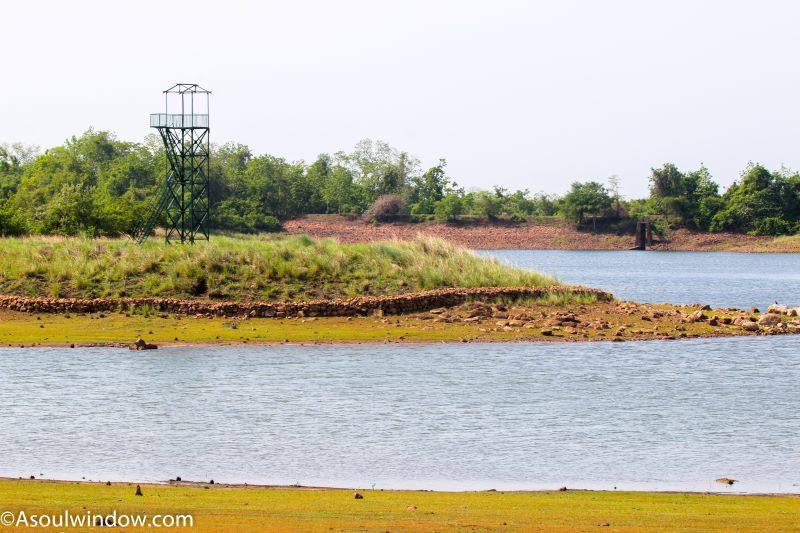
I couldn’t agree more when I arrived at the vast Telia lake surrounded by grassy knolls. Shaheen pulled out her binoculars and strained her eyes while trying to spot the orange flames. The primal beauty of the orange stripes of tiger was no-where to be seen. We were instead treated with a sighting of an Oriental darter (Anhinga melanogaster) perched on a branch in the Telia Lake. Found in tropical South Asia and Southeast Asia, I confused the Oriental darter with the cormorants which I saw in abundance in Fort Kochi and the huge Vembanad lake of Kerala in South India. Not climbing the machan at one of the shores of Telia Lake, I wondered which ferocious animals and reptiles this deceptively idyllic lake hides within and outside of its waters.
Soul Window Travel Tip
If you have entered from the Khutwanda gate, many jeep safari drivers may show hesitancy to drive up to Telia lake or Moharli gate because it is a little away, if not very. It is worth driving till Telia lake, Sonam or no Sonam.
Maya: Who is the most famous tiger in Tadoba?
Who is the legendary tiger in Tadoba? Which Tiger in Tadoba National Park is the most famous? Since many years, Maya, the fierce tigress has earned the nickname of the undisputed “Queen of Tadoba National Park”. In fact, Maya is one of the reasons why Tadoba National Park became so famous with wildlife enthusiasts.
Why is Maya tigress famous? There are many reasons behind the larger-than-life fame of Maya. What makes Maya the most famous tigress of Tadoba National Park is her:
- Smartness
- Intelligence
- Fearlessness
- Fierce behaviour
- Presence of mind
- Immense patience
- Public territorial fights
- Unmatched hunting skills
- Mock Mating with male tigers
Love Story of Maya
Maya lives up to her name which means illusion. She creates an illusion of love while mock mating with other male tigers. What makes Maya world famous is the fact that ever since she attained adulthood, she started to attract attention of almost all the male tigers of Tadoba National Park who famously began venturing into her territory. During the night safari in the buffer zone of Navegaon Ramdegi Gate, we indulged in some fresh tiger gossips involving Maya over our packed dinner of Kathi Rolls, muffins, cookies and lemonade. Waghoba Eco Lodge had arranged for the same. Shaheen told us some juicy insider information on the ‘Queen’ Maya and her famous suitors.
It is not uncommon to see Maya doing mock mating or just being spotted with 2-3 different male tigers in a single day. She mock mates with male tigers mostly to protect her cubs. She had lost her first litter of cubs after which she devised a strategy to allow other tigers to come near her. The mind games that Maya plays has been understood by humans but not by other male tigers. Thanks to her smart dealing with the male tigers, the other tigresses in the neighbouring territories have found it easier to rear their cubs without too much attention from male tigers.
It has been observed by the experts that the tigresses whether they have litter or not, usually mate with different male tigers due to high tiger density which Tadoba national Park is known for or when they have overlapping territories with more than one tigers.
Maya has had a tough life. Maya was unfortunately separated from her mother Leela at a young age due to the untimely death of the latter. This left her vulnerable to the perils of the jungle. But the adversities also made her strong and prepared for her impending queenhood. Born in December 2010 in the Tadoba’s Pandharpaoni area, she had three sisters and 1 brother. Maya seized control of her mother Leela’s territory after she passed away. Ever since, she has been ruling Tadoba.
Soul Window Moments
Our naturalist Shaheen told me that Maya is known for faking mating with other tigers. For example, she was seen faking sex with male tiger Rudra in the Pandharpaoni area, while Balram, who is much younger than her and is the father of their cubs, takes care of the litter.
This was a revelation because I had no idea that male tigers do parenting as well. Some perplexed tourists had noticed Balram moving around with cubs at the huge Tadoba lake. This strange but smart behaviour of Maya indeed is the talk of the town, or jungle, eh! We burst into laughter when Shaheen said that Rudra was like the clingy boyfriend who refused to leave Maya alone, despite many days of mock mating. The other tigers Maya has mated with are Matkasur and later Gabbar who even fought for the right to mate with her. Tala and Mowgli are other male tigers Maya mated with.
Maya is so famous that she even has a twitter handle @MayaTadoba where exciting updates on her daily life is shared.
Why tigresses protect cubs
The unrivalled skill which Maya displays in managing the male tigers is a matter of study. The unusual sexual behaviour of Maya, which has a history of mating with several males has left the experts with more questions than answers. Besides protecting the cubs from dholes or wild dogs and leopards, the tigresses have to hide them from male tigers too, who may kill the babies for various reasons. The tigresses take immense care of the cubs till the age of two after which the cubs separate from the mother, searching for their own territories. There have also been instances in Tadoba when a tigress has given birth to cubs even when the earlier litter has not separated from them.
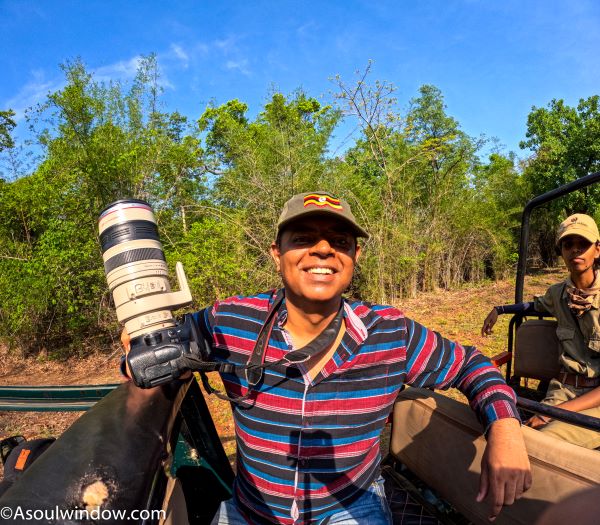
My Experience of wildlife Safari in Tadoba National Park
Navigate through the lush green forests of Tadoba National Park, I witnessed the captivating biodiversity on this wild adventure. The erudite naturalist Shaheen from Pugdundee Safaris made all the more difference to my overall experience. Despite being my first time here, the wildlife Safari in Tadoba National Park was so successfulthat I really want to come back here soon.
Fungoid frog or the Malabar Hills frog and the tree frog
Just as I stepped inside the Waghoba Eco Lodge by Pugdundee Safaris, one of the best resorts in Tadoba, I was delighted to see my first sighting right outside my plush villa. It was around 8 p.m. when I arrived here. The fungoid frog or the Malabar Hills frog (Hydrophylax malabaricus) gave us a good look before disappearing into the tall grasses, kept wild on purpose by the property. I was amused to see the colours on the fungoid frog.
They boast of a melange of colours such as brownish-red, bright crimson, blackish brown and yellow. Malabar fungoid frogs are mostly found on the lower vegetation or forest floors in the Western Ghats. Fungoid frog reminded me of the Bi Colored Frog aka Malabar frog (Clinotarsus curtipes) I spotted during the snake trail in the rainforests of Agumbe, also in Western Ghats. The unusual sighting was a sign that this trip to Tadoba National Park is going to be a success.
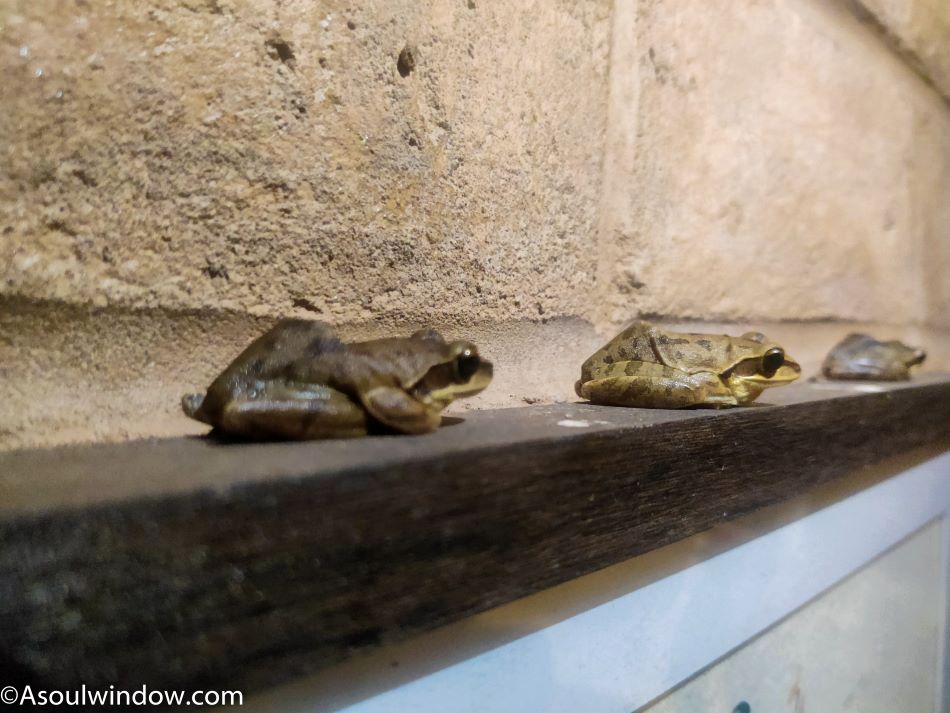
When we returned late night, around 10:30 p.m. after the exciting night safari in Tadoba, the affable manager of Waghoba Eco Lodge also made us notice another unusual species of frog. “They are our daily resident guests”, said Mr. Ghanshyam Singh with a chuckle. “Wait, is that a real frog? How did it climb up this photo frame in the middle of the wall?”, I asked him when suddenly the 3-4 frogs started moving, one even jumped atop the other. The tree frogs looked like clay figures. Known as the Indian tree frog (Polypedates maculatus) or Chunam tree frog, they are also found in other South Asian countries such as Bhutan, Sri Lanka, Nepal, Bangladesh, Myanmar and even parts of China. As I noticed on another wall of the reception of Waghoba Eco Lodge, it is easy for the Indian tree frog to climb on the top of the tall walls like lizards. Thanks to their webbed feet, they are able to climb walls with ease. Measuring only about 7–8 centimetres, I found them to be very agile, slimy and translucent.
Spotting Indian Gaur in Tadoba National Park
The first animal which I saw during the safari in Tadoba National Park was a large herd of Gaur. The cute sight of a Gaur mother breastfeeding her new born calf stayed with me for a long time. The highly muscular body of the male Gaur looked menacing. But I guess they are merely gentle giants and shy of humans. Gaurs are harmless unless threatened. The male gaur with a large dewlap and a distinctive dorsal ridge appeared huge and very powerful. There were more females than males in the herd of gaurs which I saw. During the morning safari organised by Waghoba Eco Lodges, Pugdundee Safaris in Tadoba National Park, I also noticed some male gaurs living a solitary life. Their primordial raw power of the male gaur has few parallels. The female gaurs are comparatively smaller in size.
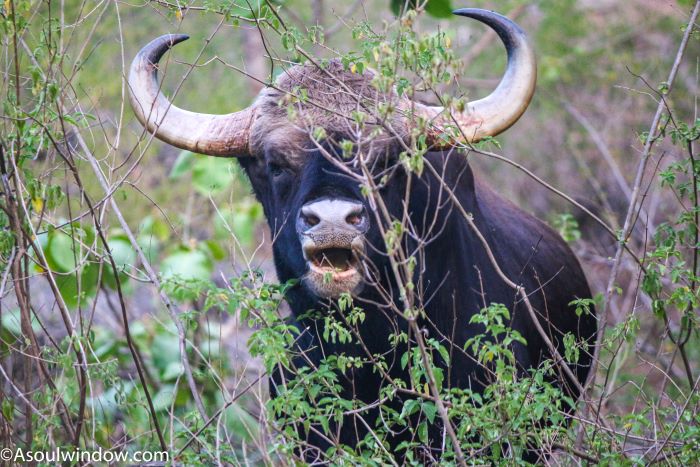
Soul Window Facts
Did you know that the Indian Gaur is the largest species of wild cattle. They are even bigger than the Cape Buffalo, Water Buffalo and Bison. The average weight of male Indian gaurs is 1300 kilograms. Male Gaurs weighing 1700 kilograms is also not unheard of. If we compare this with Malayan gaur aka seladang, they weigh around 1000-1300 kilograms.
Gaurs are native to the countries in South Asia and Southeast Asia. I have seen many gayal (Bos frontalis) or Mithun in North East Indian states such as Arunachal Pradesh. Mithun is the domesticated form of Indian Gaur. Gaur is sadly extinct from Sri Lanka.
Wildlife Sightings on a jeep safari in Tadoba National Park
A sounder of wild boar and few crows goofed around as we drove in search of the elusive tiger. Random calls made by spotted deer and Hanuman langur and scrutinising the roads for pugmarks of Tigers was our only success so far. Till we had our Tiger moment, we appreciated other flora and fauna of the vast and biodiverse Tadoba Andhari Tiger Reserve. While we didn’t get to see sloth bear (Melursus ursinus), we saw bear claw marks on jamun tree trunks. “It’s mid-June and no one has seen a sloth bear in Tadoba National Park, this year.”, said Shahin matter-of-factly to keep my expectations low when I enquired about the chances of spotting one.
Bear or no bear, Tadoba is teaming with wildlife. In the pursuit of spotting a Royal Bengal Tiger, we ended up seeing many other species of birds and animals such as Grey jungle fowl, Red spurfowl, yellow footed green pigeons, Indian Roller, Chital, Marsh Crocodile and even a dancing peacock. It was the first time when I saw a dancing peacock in wild so closely. Earlier I had seen a dancing peacock in Manas National Park in Assam, North East India, but the peacock was quite far away. It was a sight to behold. A day later, I saw a dancing peacock from a close distance in Pench National Park in Madhya Pradesh as well. Do read about it on my blog on birdwatching in Pench National Park.
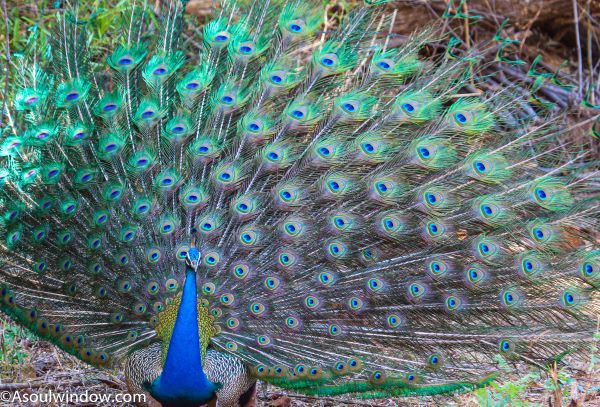
It was also my first sighting of grey jungle fowl. I saw them 2-3 times. My mistake was that I thought, I will take their pictures after I see the tiger, but they never appeared again. Sightings are unpredictable in a jungle. This is why, we must click shots as and when you can. I also got a great view of many Sambar deer drinking water and relaxing by a small pond. They were pretty close to us. My wandering eyes rested on a full-grown male sambar. He does not flee or flinch.It was an unusual sight when I compare it to the fleeting glimpses of sambar I saw elsewhere such as Satpura National Park or Bandhavgarh National Park, both in Madhya Pradesh, the official tiger paradise. In other corner, the massive silhouetted male Sambar stood so still that it seems almost sculptural in the thinning dark.
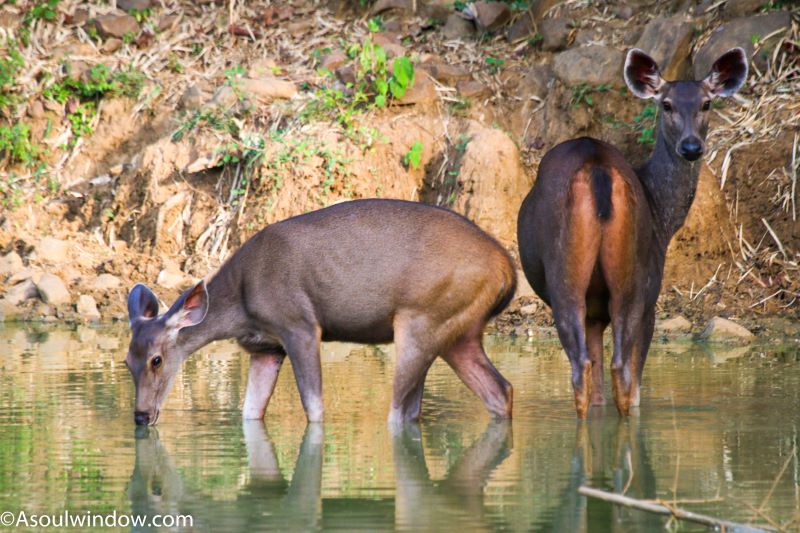
Which gate is best for tiger sighting in Tadoba?
- Which gate at Tadoba is best?
- Which gate is best for tiger sighting in Tadoba?
- Which zone is best for tiger spotting in Tadoba?
- Which zone is best for spotting tigers in Tadoba National Park?
Thes are some frequently asked questions. In my experience, Khutwanada gate near Waghoba Eco Lodge turned out to be a good choice for spotting tigers and other wild animals in Tadoba National Park.
The Moharli Gate which is easily accessible from other two zone of Tadoba called as Tadoba Zone and Kolsa Zone is also very popular with tourists. In fact, we started from Khutwanda gate and reached Moharli gate area via Kolsa Gate, so it doesn’t really make much difference. The gates are interconnected and can be easily accessed.
Best zone for tiger sighting in Tadoba depends on a lot of factors. We had amazing tiger sighting at Khutwanda Zone while we didn’t see much near the Moharli gate. It all depends on the day and the recent movement of the tigers. So, always ask around.
The main gates of Tadoba National Park are:
- Zari Gate
- Pangdi Gate
- Khutwanda Gate (I did morning safari here)
- Kolara Gate (I visited Kolara Gate from Khutwanda)
- Moharli Gate (I visited Moharli Gate from Khutwanda)
- Navegaon Ramdegi Gate (I did Night Safari here in the buffer zone)
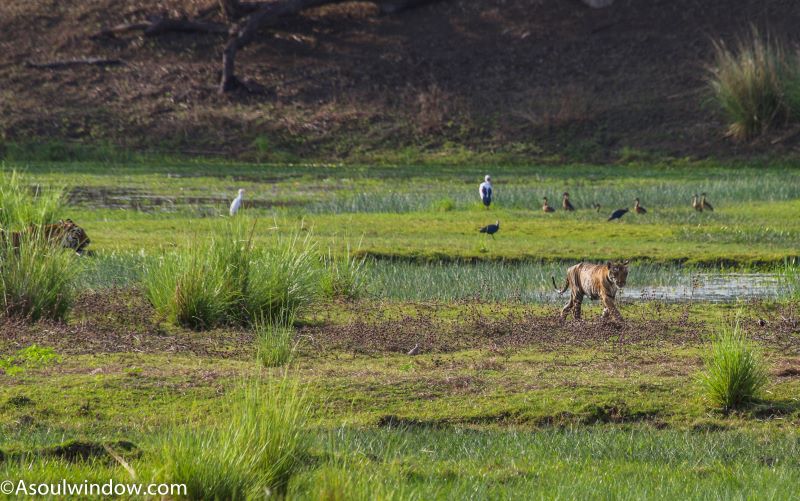
FAQ: Frequently asked questions
Based on my own personal experiences, I am answering below in great detail the commonly asked questions about Tiger Safari in Tadoba National Park.
How to book a Tiger Safari in Tadoba National Park?
This is a commonly asked question.Even before I had arrived in Nagpur, Waghoba Eco Lodge by Pugdundee Safaris had booked a night safari and early morning Tiger Safari in Tadoba National Park, Maharashtra. All I had to do was email them my Photo Id card and the rest was taken care of by Pugdundee safaris. Since the tiger safaris get booked real fast in Tadoba Andhari Tiger Reserve, we never really had to deal with trying to find a spot because Waghoba Eco Lodge had arranged for the same even at the last minute. Now you know why Pugdundee Safaris are experts at organising tiger safaris in India.
I had submitted Aadhar Card copy with the property management. Many foreigners from countries such as USA, UK, Canada, Australia, New Zealand, Germany, Netherlands, Italy and France etc also visit Tadoba National Park. Such foreigner wildlife enthusiasts have to submit a passport copy. It is best to request the management of the hotel to book the safari for you, so that you are saved from the hassle of booking one by yourself.
Soul Window Travel Tips for Tiger Safari in Tadoba National Park
· You must note that the jeep safaris in the core zone remains closed on Tuesdays while the jeep tiger safaris remain closed on Wednesdays in the buffer zone.
· All the properties such as Waghoba Eco Lodge remains open in monsoon from July to October. While the Jeep Safari is not allowed in the core zone of Tadoba, it is allowed in the buffer zone during the rainy season.
Soul Window Travel Tips
Always carry the same ID such as Aadhar Card, Voter’s ID card or Passport during all jeep safari in Tadoba National Park. It should be same as the one you had used at the time of booking the permit for safari. The ID was checked again by the forest officials when I entered the Khutwanda gate of Tadoba.
How many tiger safaris should I do in Tadoba?
There is no limit. Every experience is a new experience.
Where to stay in Tadoba National Park?
I had heard rave reviews of Waghoba Eco Lodge from friends even before staying here. It is located near the core area of Tadoba National Park. What sets apart this charming wildlife property is its minimalism, a respect for all things local and the sustainable measures it takes without compromising on luxury.
Factors such as luxurious well-appointed rooms, great local food, courteous staff, erudite in-house naturalists, organic vegetables grown in the huge kitchen garden, a hide for birdwatchers, facility for screening of documentaries on wildlife etc make Waghoba Eco Lodge one of the best places to stay in Tadoba National Park. I also loved that they kept the surroundings wild and untamed.
What is the best Time to visit Tadoba National Park to spot Tigers?
Which are the best times of day to see tigers? Morning and evening are the best time to spot a tiger in a jeep safari. What time is tiger most active? Tigers are very active during the morning.
Summer is the best time to visit Tadoba National Park to spot Tigers because the tigers stay close to water body due to extreme heat. However, having said that, my friends have had amazing tiger sightings in winter months such as January as well. In summer, the tigers sit in or around the water body to keep themselves cool. Therefore, the probability of spotting a tiger in wild is a bit higher in summer.
The shade of the wet green land must have been comforting for Bijli and her two cubs in the extreme heat of Vidarbha region of Maharashtra in West India. Located in the Chandrapur District, Tadoba-Andhari Tiger Reserve can get very hot in mid-June, also the time when I visited. But then the hotter it is, the better it is to spot a tiger in wild. No wonder, I had seen 6 tigers in a day in Ranthambore National Park during peak summer. But then Ranthambore is also touristy unlike Tadoba Andhari Tiger Reserve, which also happens to be one of the oldest and largest national parks of Maharashtra.
What are the chances of sighting tiger in Tadoba National Park?
Can we see tiger in Tadoba? Yes, of course. You too can spot tigers in Tadoba Andhari Tiger Reserve (in short TATR) like I did. In fact, Tadoba National Park is one of the best tiger reserves in India where you can spot the elusive Royal Bengal Tiger in its prime habitat. In my experience, in peak summers, the chances of spotting a tiger in Tadoba National Park is higher as they can easily be found in the open, especially near a water body.
How to reach Tadoba National Park?
It is very easy to arrive at Tadoba National Park. Most of the people reach Tadoba National Park from Nagpur.
By Flight
Dr. Babasaheb Ambedkar International Airport or Sonegaon Airport. Mostly ATR aircrafts ply on this route. It is a leading regional aircraft manufacturer. There are limited options for small sectors like these and the prices may go up soon. So, it is a good idea to book in advance. Sonegaon Airport is a modern airport with great facilities. You can hire a cab to Tadoba National Park, right outside the airport.
Road Trip
The road from Nagpur to Tadoba are baby bottom smooth. In my case, Waghoba Eco Lodges by Pugdundee Safaris arranged for a cab pick-up for us. It made things easy and quick for me. Besides saving my time, it saved me and Ami from the hassle of dealing with competing cab drivers. Including a break for loo and snacks, it took us only 2 hours and 30 minutes to reach Tadoba National Park from Sonegaon Airport on smooth, empty roads. We even enjoyed local food on Maharashtra en route.
Railway
The nearest railhead from the Tadoba National Park is located at the Chandrapur Railway Station. The major railway station from Tadoba is located in Nagpur. If you are traveling from Mumbai, you can hop on the Vidarbha Express. It leaves Mumbai at 7.40 p.m. and arrives at 9.40 a.m.
Bus
Buses are also easily available.



Soul Window Facts
Did you know that Pench National Park lies in both Madhya Pradesh as well as Maharashtra? Much like Tadoba National Park, Pench National Park is also located close to Nagpur. Tourists visiting Pench National Park and Tadoba National Park get down at Nagpur airport and drive down. Like I did.
In fact, I have also visited the Maharashtra part of Pench National Park. I had entered the dense forest from the Khursapar Gate of Pench National Park which lies in Maharashtra. I have also entered Pench National Park through Turia Gate and Karmajhiri Gate.
I am mentioning these so that you understand the geography of Tadoba National Park and Pench National Park and how easy and convenient it is to club both national parks on one trip.


Conclusion: Is it easy to spot a Tiger in Tadoba National Park?
Here is an overview. Grinding along dirt roads, as I embarked on a wild adventure in Tadoba National Park, it promised unforgettable encounters with nature’s regal predators the Royal Bengal Tiger and other wild animals and birds. As we cut through the canopies of thick teak trees and bamboo forests of Tadoba-Andhari Tiger Reserve (TATR), we were rewarded with a sighting of an animal, bird or reptile every few seconds. And who knows, you may also end up seeing tigers and the rare melanistic leopard called as blackie. Based on my personal experience, I realised that it is rather easy to see tigers in the Tadoba National Park.
The view from my Soul Window is majestic!
Top Travel Blogger from India
